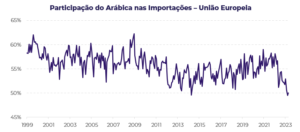Coffee Consumption Trends and impacts on commodity markets
Natália Gandolphi, Market Intelligence Analyst at hEDGEpoint, talks about coffee consumption trends, and their impacts on the global commodity chain.
Understanding coffee consumption trends is vital for everyone involved in this commodity’s global chain. After all, this market has enormous relevance for the economies of many countries, and the commodity itself is indispensable in the daily lives of innumerable people.
According to International Coffee Organization (ICO) data, the estimated world production for the 2022/23 crop was 171.3 million bags, a number that represents an increase of 1.7% compared to the previous cycle.
The global coffee consumption forecast for the current harvest in progress is that demand should reach around 178.5 million (60-kg.) bags. This quantity also represents an increase of 1.7% related to the same period the previous year.
In view of this scenario, it’s essential that we monitor changes in coffee consumption in order to manage the risks that may affect the entire coffee market. With this in mind, we invited Natália Gandolphi, Market Intelligence Analyst at hEDGEpoint, to discuss the main consumer trends and their impacts.
Continue reading to learn more on the subject!
Recognize the major coffee types and the differences between them
Our planet has four major coffee types: Arabica, Robusta, Liberica, and Excelsa. Among them, only two dominate world trade: Arabica and Canephora beans (also called Conilon or Robusta). The main difference between these two varieties is the number of chromosomes belonging to each species.
While conilon has 22 pairs of chromosomes that contain the plant’s genetic material, arabica has twice as many. In practice, this means there are different ways of growing and tasting diverse coffees. We’ll explain the other significant differences between them below:
- Arabica Coffee: It requires greater care in cultivation and handling and a gentler climate. It’s considered refined and has a milder taste. It presents better conditions to offer different aromas, which can be categorized into chocolatey, fruity, and floral notes.
- Conilon Coffee: It’s grown mainly in more humid, warmer climates. With greater resistance, and constant, abundant production, it has a lower monetary value than arabica coffee. This variety’s bean tends to have a more bitter taste.
What are the main coffee consumption trends on a global scale?
As Natália Gandolfi explains, when we talk about coffee consumption, there may be a migration of preference from more expensive coffees to cheaper ones.

Natália Gandolphi, Market Intelligence Analyst
“This is happening in response to macroeconomic conditions, in a global context of high inflation and high interest rates, which reduce purchasing power,” she clarified.
One of the consequences of this scenario is that consumption tends to migrate from arabica coffee to canephora because it costs the consumer less. Just to give you an idea: the quantity of arabica coffee imports to the European Union (EU) is at its lowest level since 1999. According to Gandolfi, EU nations are hence seeking to increase imports of robusta coffee beans, mainly from countries in Asia and Africa, the major producers of this variety.
Arabica’s share of total imports – European Union (EU)

Source: Eurostat, hEDGEpoint Global Markets
For the 22/23 coffee cycle, a deficit is expected for both arabica and robusta coffee beans. As for the 23/24 cycle, arabica should present a surplus and put pressure on price arbitrage, with the tendency for demand to grow in countries like Brazil.
The world 22/23 coffee crop’s deficit was mainly due to the reduction in Brazilian production due to adverse weather conditions. From this scenario, we can observe other consumption trends such as:
- The switch from going out to coffee shops to drinking coffee at home happened, as international supply is lower than demand. The increase in inflation has also emphasized the need to save.
- Sustainability is already a reality for producers, who respond to this demand from consumers by continuing to adopt ESG (environmental, social, and governance) practices. Society is searching for more knowledge while it deeply analyzes manufacturing processes. Thus, producers need to develop and adopt more sustainable methods, making this bond with the consumer stronger.
What explains the migration to robusta coffee?
Gandolphi points out that this migration is directly related to the scenarios before and after the COVID-19 pandemic.
“When we entered the pandemic, there were aid policies made available to families. At that time, savings were also high. Consumption didn’t feel the impact so much, and arabica coffee continued to have high sales numbers,” she explained.
However, as we reached the end of the pandemic, savings became depleted. Aid was also terminated, accompanying a deterioration in purchasing power and high inflation globally.
“We no longer have government aid, savings levels have been reduced, and inflation is persistent in nations like the U.S., the main importer of coffee in the world. Banks in several countries have raised interest rates to control the situation. The result? Direct impacts on consumers, who felt all these effects in their pockets,” Gandolphi added.
The Coffee Market: Effects will be felt in the long term
With the end consumer looking for cheaper coffee, producers will need to adapt production to meet this demand. Gandolfi stressed that coffee is a perennial crop—that is, the decision to plant today will be reflected in the supply over the next two to three years.
“The dynamics we see today won’t necessarily be reflected in the next cycle, but rather from the 24/25 harvest. In Brazil, for example, the world’s largest coffee producer, we’re seeing an increase in conilon coffee plantations, corresponding to the trend of increased consumption of this bean,” she remarked.
Another factor that could impact coffee production in the long term is associated with climate issues. Gandolphi points out that temperature increases interfere with the production of arabica coffee, which is less resistant to heat: “It needs more rain and milder temperatures, while conilon can withstand higher temperatures and longer periods of drought,” she stated.
When we look at the climate change issue, this is a long-term challenge that could affect the entire coffee cycle. If temperatures continue to rise, the cultivation of robusta coffee should grow even more, as it adapts better to these conditions.
Global Temperatures Hit New Records

Fonte: Instituto de Mudanças Climáticas, Universidade de Maine
hEDGEpoint: Understand scenarios to manage risks
With these new consumption trends, climate change, and global macroeconomic effects, the coffee market is constantly subject to price volatility. It’s critical to have a plan that can provide more security and protection to all those involved in this commodity chain.
The best option to manage risk is provided by hEDGEpoint. We have extensive knowledge of the coffee sector to better understand new dynamics and offer the most effective hedging products.
Talk to a hEDGEpoint specialist today to learn more about how we can help your business.






